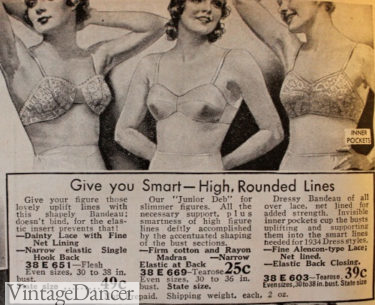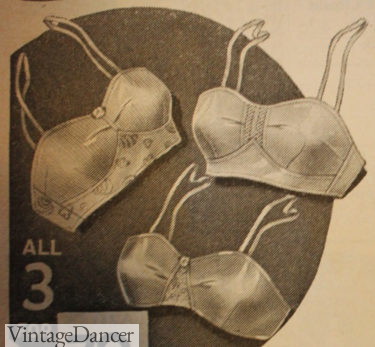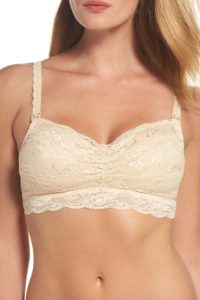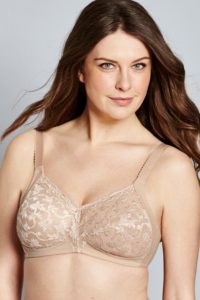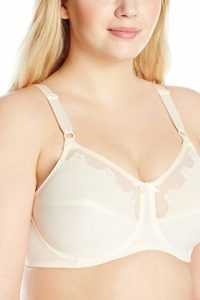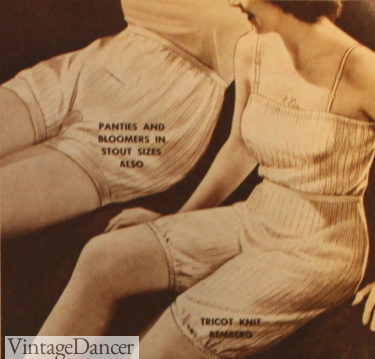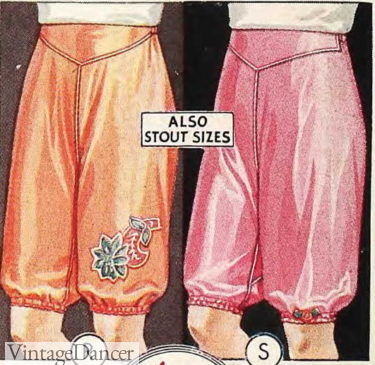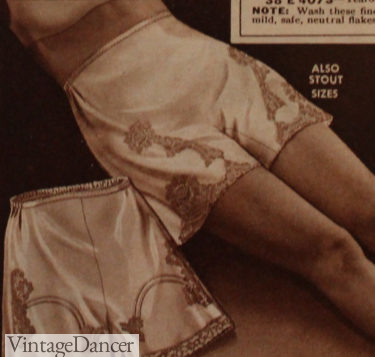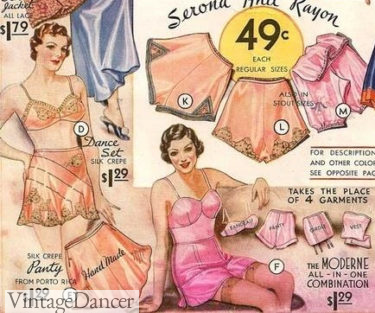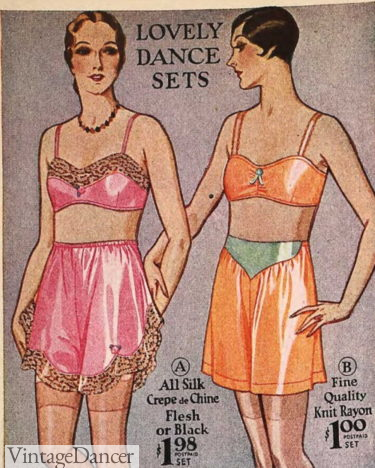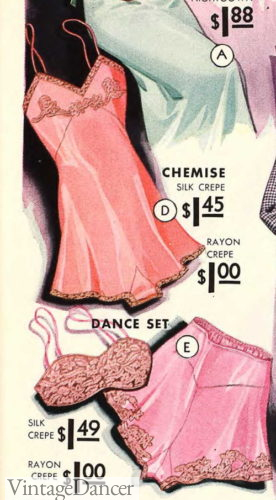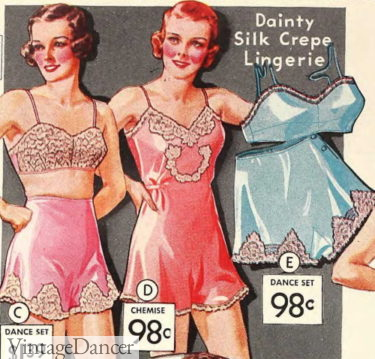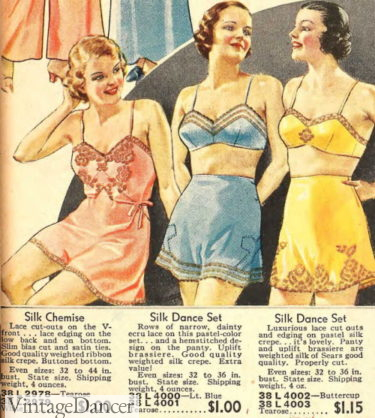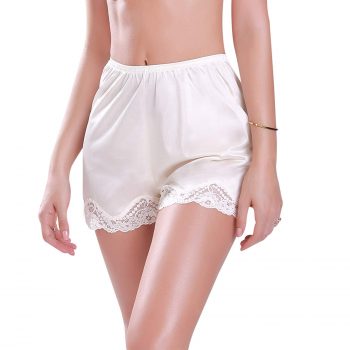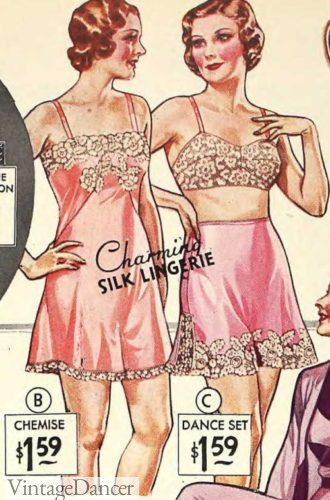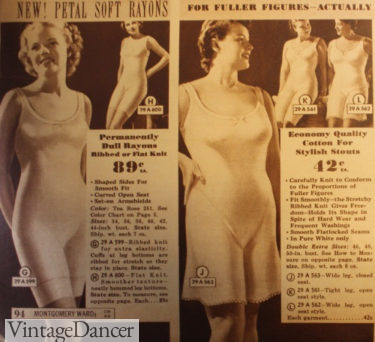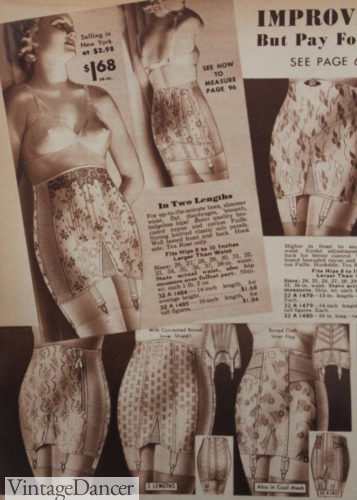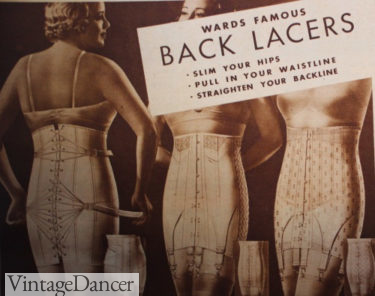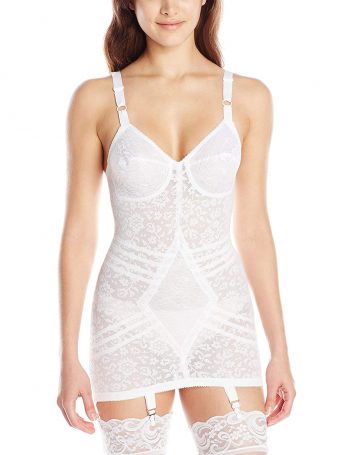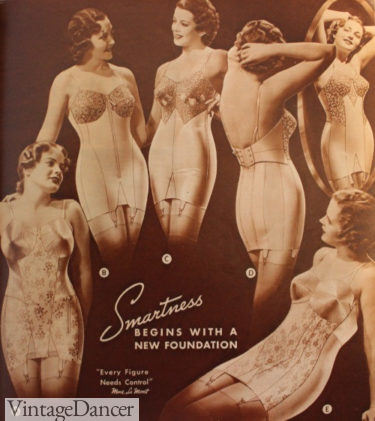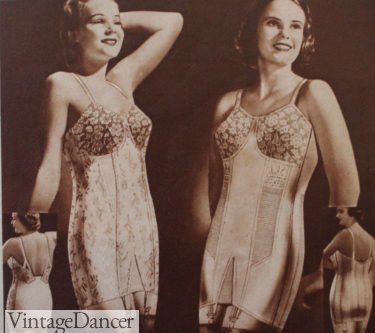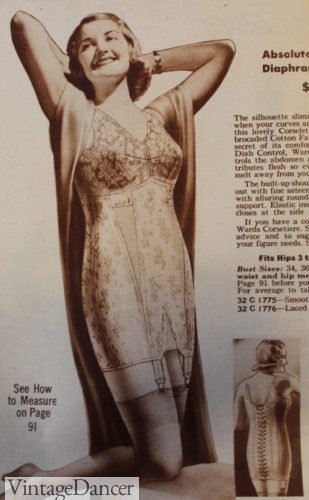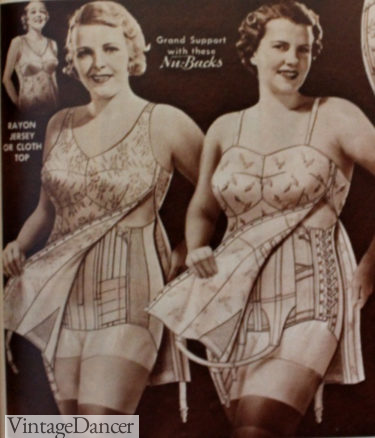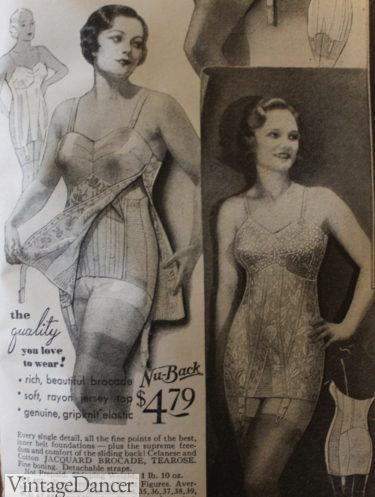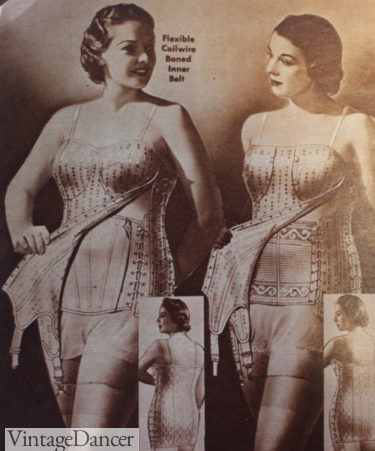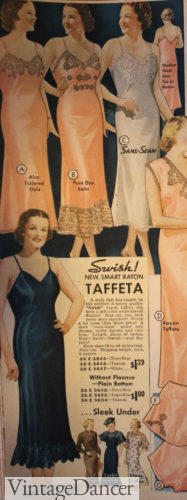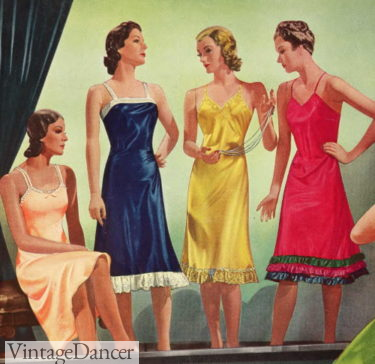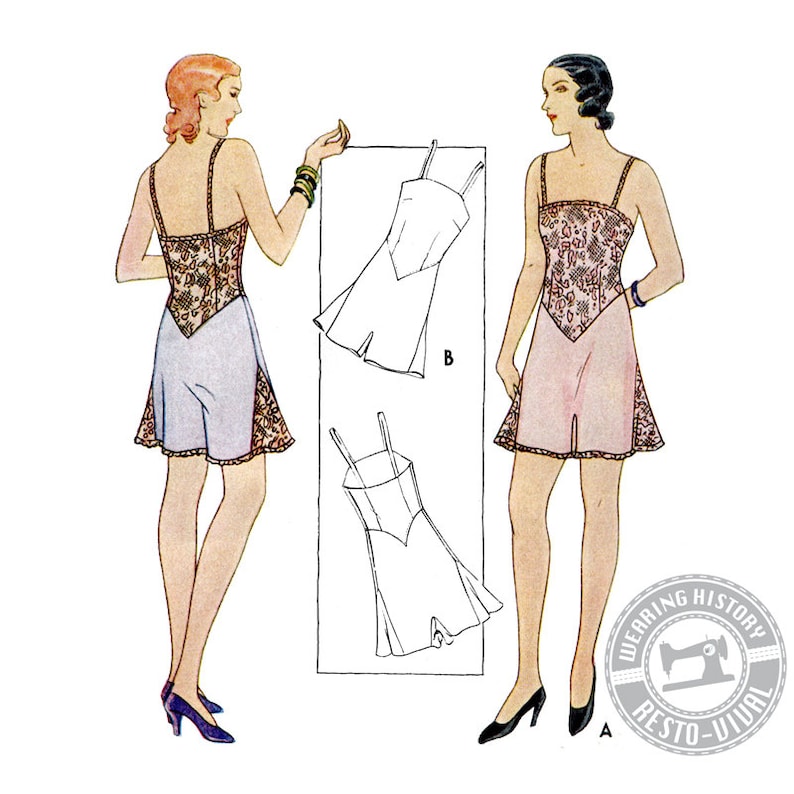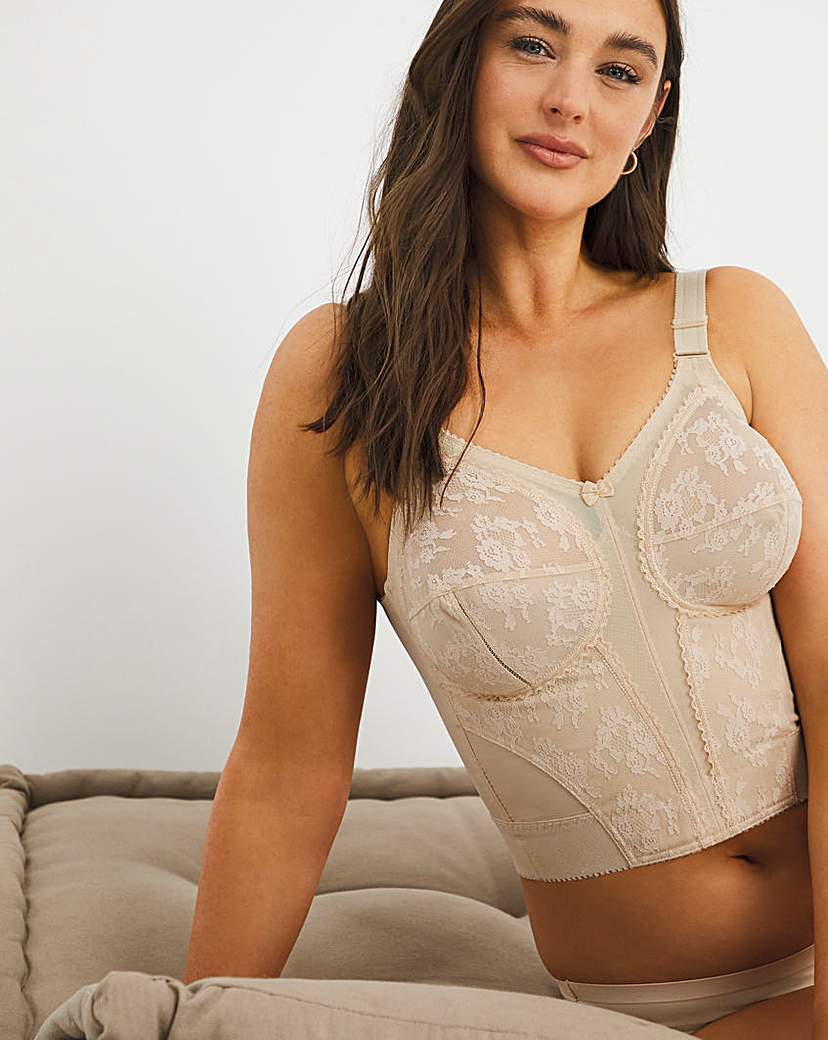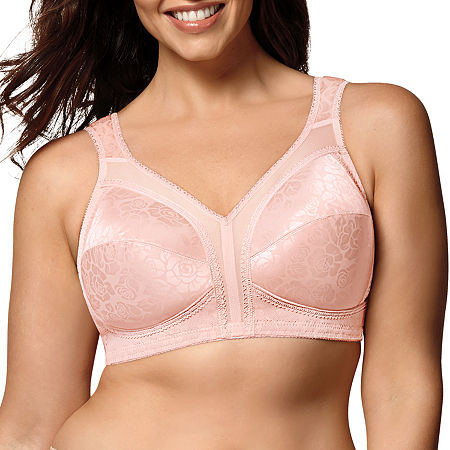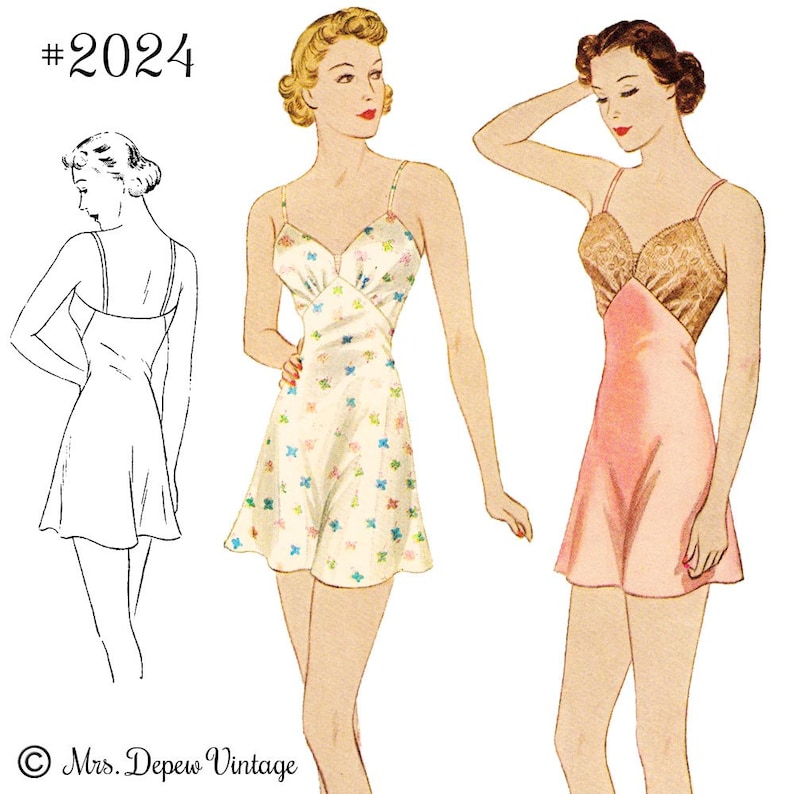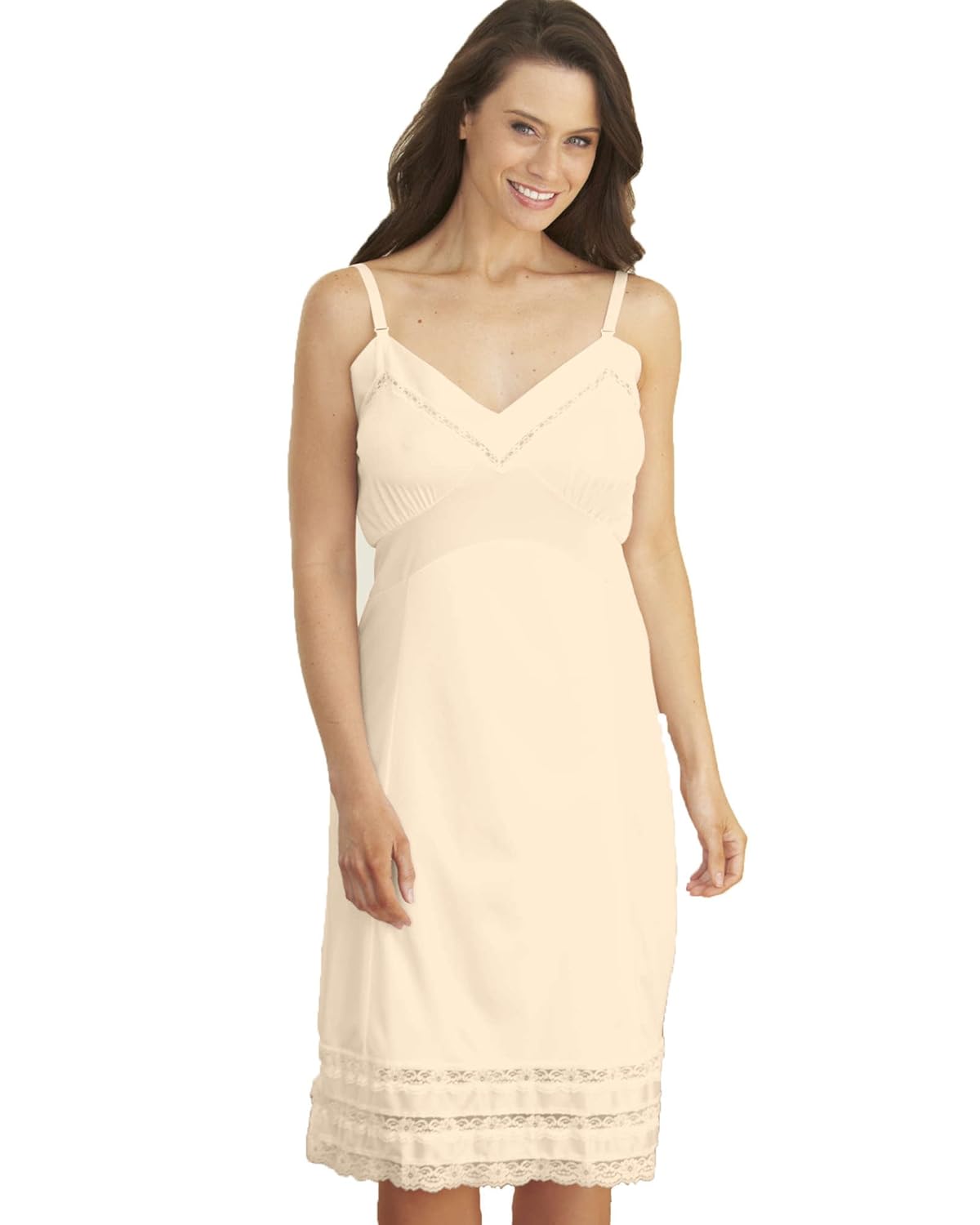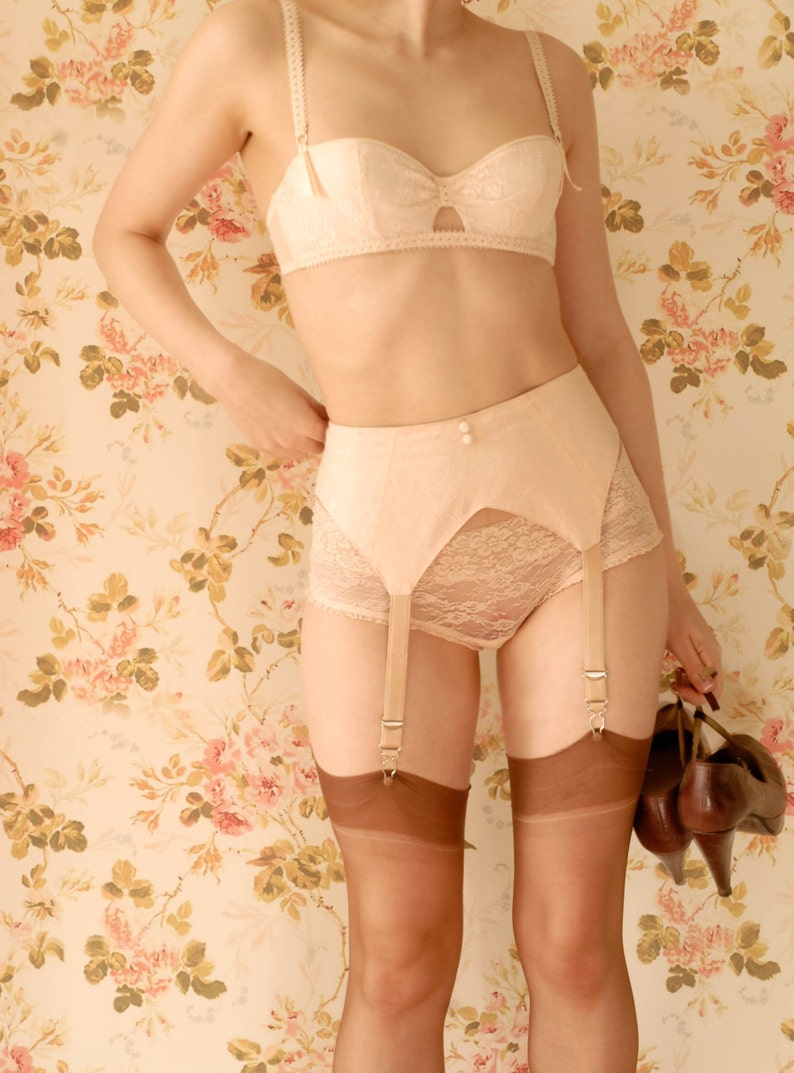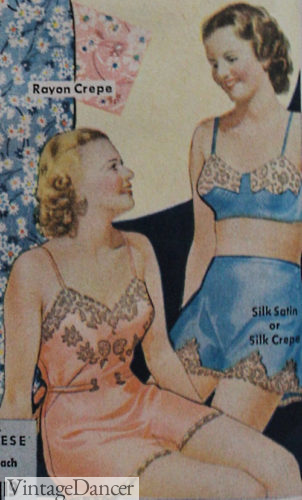
1937 chemise and dance set lingerie
With a change in women’s fashion from flat chested tubes of the 1920s to a natural feminine silhouette, women’s 1930s lingerie played an even more critical role. As of 1929, women had waists at the waistline, breasts that were small but lifted, and flat tummies with narrow hips.
An elongated figure was still the overall goal, but with the new bias cut dresses clinging to every curve, women needed foundation undergarments to enhance the right curves and smooth out the wrong ones.
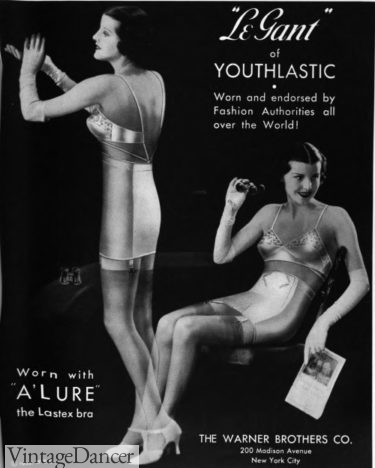
1936 WB ad in Vogue for shapewear lingerie
1930s lingerie fabrics moved more towards shiny silk, satin crepe, crepe de chine, yarn crepe, watered crepe mousseline, and satin georgette. The slipperiness of the fabric aided in draping thin clothing over the body. Small hooks or zippers on the back, side, or front secured them in place with minimal bulge.
Popular lingerie colors were tea rose (pink), peach, white, flesh (cream) and occasionally orchid purple, light blue, nile green, buttercup yellow and black. With delicate lace trimming bras, panties and slips the 1930s are regarded as one of the prettiest decades for lingerie.
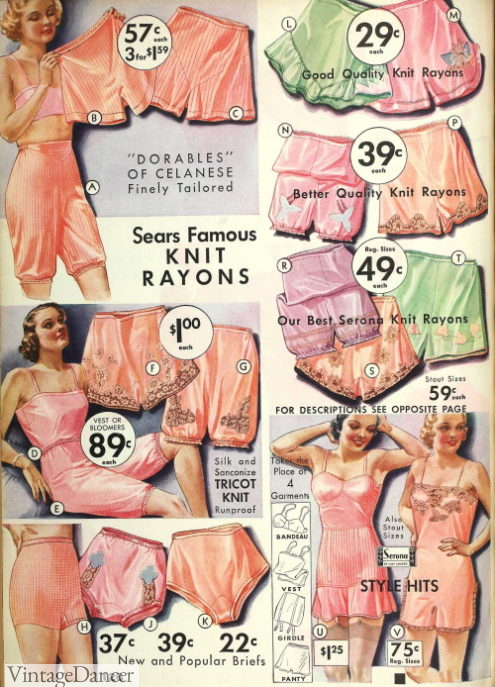
1935 lingerie in pretty pastel colors
Bra, brassiere
The simple tube bra of the ’20s gave way to the “separate, lift, and support” bras of the ’30s. The fabric was quite light and thin shaped in a variety of triangles, cones, and cups to accommodate different breast sizes and shapes. Some were lined for extra support. Breast sizes were becoming standardized as well. Most lingerie brands adopted the A-D size chart.
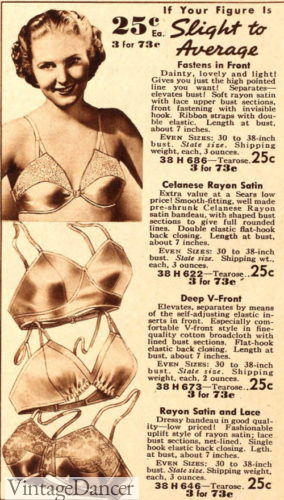
1938 bras for small to average busts
The bandeau shape was a carryover from the ’20s but now with a panel in the middle to create separation. Shaped like a tube around the bust with thin shoulder straps, it offered minimal support. For women with too little bust, there were bandeau bras with cup inserts – just enough to provide some shape.
- 1933 bandeau shaped bras
- 1933 bandeau bras
Cup bras were like bandeaus but with a defined inner shelf, cup, cone, or pocket lining that provided extra support and lift. They often extended down the ribcage a few inches to provide more stabilization. The magic was in the inner structure while the outside was pretty with lace overlays, contrast stitching, and embroidery.
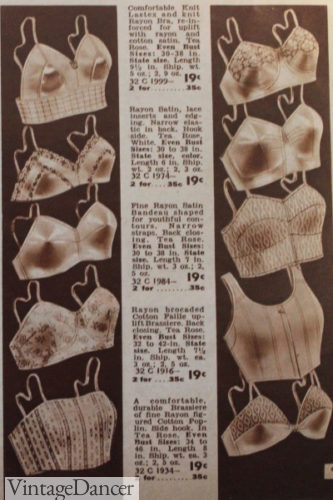
1938 bra styles- bandeau, cup, and minimizers
Full cup bras were not an option yet for busty ladies. Instead, breasts were minimized with something that looked like a corset for the bust, or a stiff modern day sports bra that extended down the torso a few inches to mid tummy. A clip in the center attached to girdles, making the set almost an all-in-one.
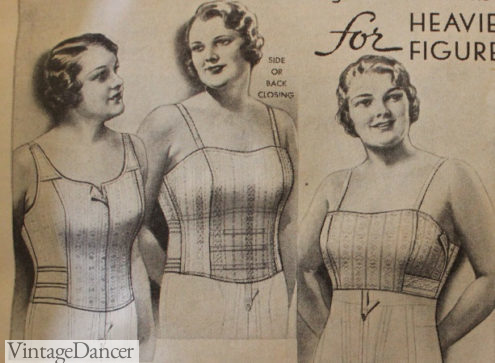
1933 minimizer bras
1930s style bras today. For smaller chested A/B women, the bandeau bra is ideal for a 1930s look. Sometimes, these are called bralettes or a longline bralette. Lace triangle bras are another option for something light and simple. C/D sized women could use a non-underwire cup bra with little to no padding. The cup shouldn’t be perfectly smooth but triangles pieced together.
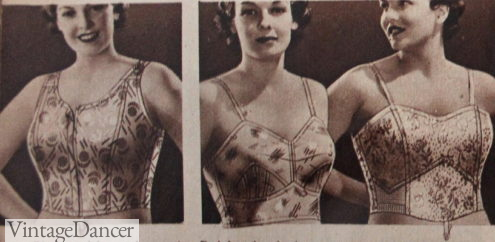
1938 longline minimizer bras for full figure busts
The Wacoal Retro chic bra, Bali Flower bra, and similar “cheap” bras are ideal for most vintage decades. Modern minimizer bras have changed little from the ’30s, so go ahead and wear one if you need to reduce your chest volume.
What doesn’t work well for the ’30s is most modern T-shirt bras that perfectly smooth the breast into a ball and then push them out to the sides. 1930s breasts were front and center with a little lift to keep them perky. The difference is night and day when wearing vintage clothing (shop these at the end of the article).
- Bralette / bandeau bra
- No-underwire bra
- Bali Flower bra – full cup support, vintage shape
Panties / Underwear
Women’s 1930s underwear came in three distinct types. Each design was decorated with lace trim or insets, embroidery, and small bows. Popular colors were all shades of light rose pink, peach, and white. Fabrics were knit rayon, cotton, tricot, satin, and silk. Striped satin underwear was a big trend in the later half of the decade.
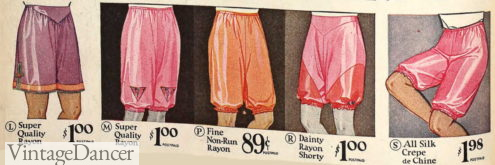
1930 panty selections (longer lengths)
Bloomers – high waist, long leg bloomers with elastic tops and legs were the carryover style from the 1920s. Legs were around 20 inches long – the perfect length to prevent thigh rub.
- 1933 Knit bloomers Underwear
- 1931 bloomer panties with yoke brand
Panties– Step in panties (later called tap pants) were high waist and medium to short length legged shorts with a flared open leg. These were the newest underwear models available, and were very popular for most of the decade.
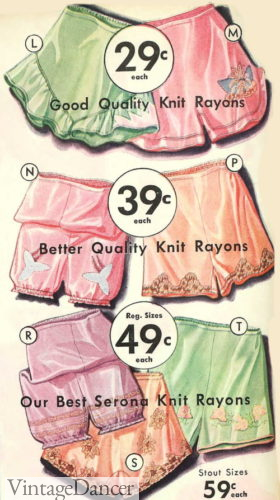
1935 pretty rayon panties
- 1933 panties with lace insets and trim
- Late 30s panties
The panty and soft bra were often sold in matching sets, called Dance Sets. A step-in chemise was worn over them to create a smooth underwear set that allowed ample movement for dancing the tango, lindy and balboa.
- 1930 dance sets
- 1934 chemise and dance set
- 1935 dance sets with chemise
- 1936 chemise and dance sets
Briefs appeared in the mid to late ’30s. They are the base for modern panties today. Briefs had a high waist with a ribbed leg band that circled around the thigh and next to the crotch. They were advertised to young women, although the plain knit varieties were certainly not pretty enough for fashion savvy teens.
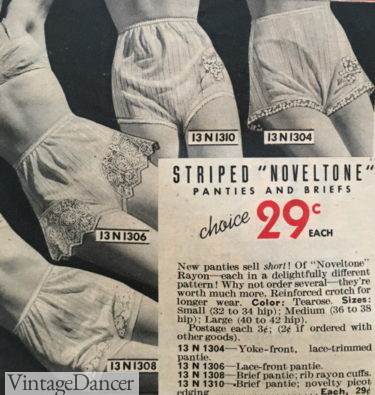
1937 brief knit rayon panties
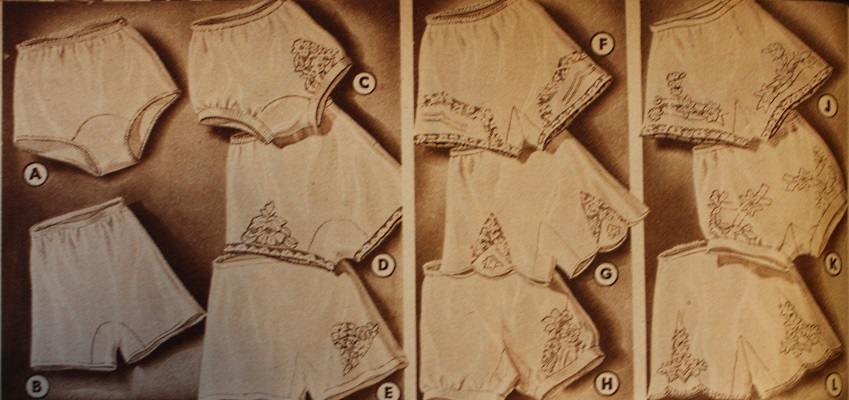
1938 underwear- briefs (top) and panties (bottom)
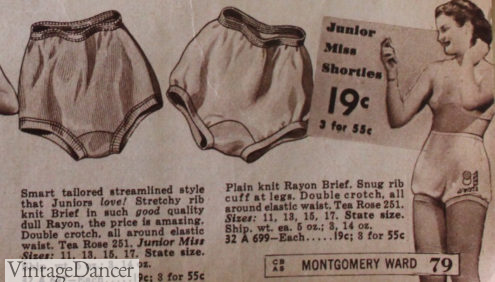
1937 knit briefs for teens (Notice the fit is not tight but bubbled around the legs)
Step-Ins / Chemise
The All-in-one combination or step-in underwear was a revolutionary new style in the 1920s to mid-30s. The step-in was an easy way to combine a bra, slip, and panty or bloomer in one piece. Unlike the ’20s versions, the ’30s step-ins were cut on the bias, shaping the lingerie to the body and supporting the tailored dress of the era.
- 1933 chemise
- 1934 chemise and dance set
Unfortunately, bra and panty separates with a long slip proved to be the more popular option as well as the most practical for using the restroom. The step-in was all but gone by the 1940s, with the exception of a cotton rib knit version that was a warm winter favorite (similar to short long johns).
- 1937 Ribbed knit cotton step-in underwear for winter
Girdles
“No real chic is possible, even with a dress tailored by a master dress designer, if your line is not prepared first.” Charmis ad, 1937
The word girdle sends chills down the backs of any woman who remembers wearing one. They were an essential item of women’s lingerie for achieving the perfect flat silhouette, yet they were not without some discomfort (however, a properly fitted girdle or corset shouldn’t be too tight).
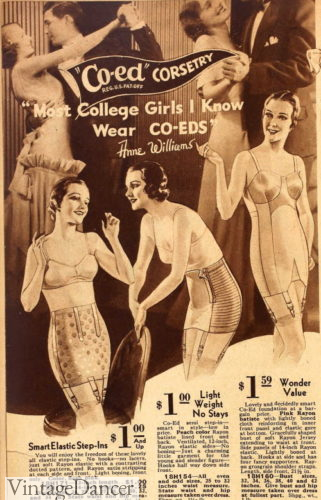
1932 Co-Ed girdles
Lastex, a flexible early elastic developed in 1931, was a game changer for lingerie — especially girdles. Women could wear a girdle and move, bend, play sports, and look good in an evening gown. Young women who had never know the stiffness of a boned Victorian-era corset were enchanted by this new technology. In the 1920s, they didn’t need a girdle, but in the 1930s it was required that underwear fit like a glove from bust to thigh.
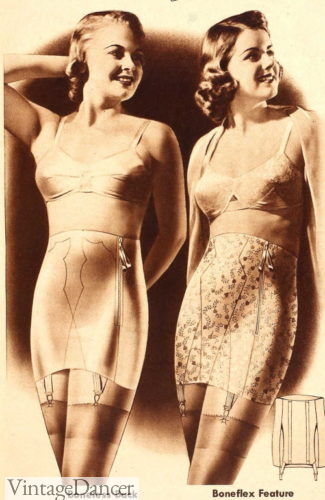
1938 zipper girdles
A well-to-do woman owned three girdles: one for sport, one for shopping, and one for evening gowns. It was shaped like a snug, short skirt (or pantie girdle) with a V notch elastic panel in the front to make walking easier. Many had some boning to keep the Lastex from riding up.
The top was curved up to keep the tummy flat and sometimes meet a longline bra with corset clip. The legs had garter clips to attach to stockings. This, more than body shaping, was the real reason women needed to wear a girdle. Without stocking clips, hosiery would gradually fall down the leg.
Girdles for full figures came with boning, double layers of elastic and stiff fabric and laces at the back to adjust fit all around. Many rose higher at the back and extended lower on the leg to offer maximum coverage. These were usually not worn around the house but on special occasions when “looking her best” was important.
- 1938 girdles for stout women
- 1938 corset with back lacing
Corselets and Corsets
The girdle was ideal for slender women. Once a woman had a little bit of flesh, the girdle would cause deep lines or rolls above the waist and around to the back. Her only choice was to step up into an all-in-one corset.
Contrary to popular belief, the corset was not a torture device. The 1930s corset’s purpose was to provide a foundation for the dress to hang correctly. The corset shaped a body into a silhouette that was long and lean in the first part of the 1930s, and curvy in the later years. While somewhat restrictive, they were never intended to be oppressive. Most designs aimed to improve breathability and flexibility with the use of new breathable materials, Lastex panels, and lacing.
- 1933 “Every figure needs support” with a corselet
- 1938 Lasttix corselets
- 1938 back lacing corselet
The corset could be a simple step-in style with a bra and girdle attached together called a corselet. An all-in-one corselet was the preferred lingerie piece for evening wear or fancy afternoon dress. Backless and strapless corselettes were designed to go under the new backless and halter neck evening gowns.
Stout women who needed a bit more support controlling the diaphragm chose a layered corset. The inner layer, called a belt, was a stomach girdle that had multiple adjustments options, such as lacing to cinch in trouble spots. The outer layer was a smooth corselet from the bra down to the thigh.
- 1933 belt and corset set with side lacing
- 1933 layered corset
- 1938 corsets for stout figures
Slips
The final layer in women’s lingerie was the slip. With longer dresses came the need for longer slips, as well as slips cut on the bias so they clung to the body just like ’30s dresses. Slips that were too clingy did little to drape the outer dress correctly, so instead the bust was fitted snug but the rest hung down on the bias, skimming the body with a little room to spare
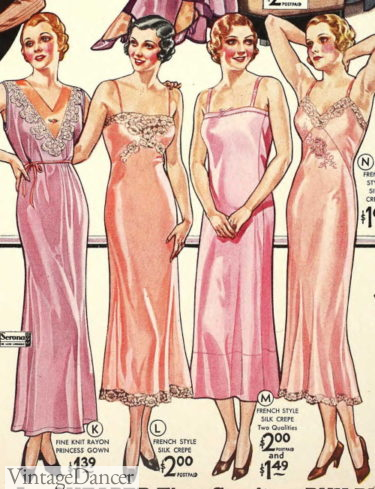
1933 slips
Slips featured thin straps with a square, scoop, or V neckline. Delicate lace trimmed the bust line and hem on fancier models. The body was cut on the bias with a tad more flare from the knee down. The length was sold based on a woman’s height with the goal of the slip hanging down to within an inch or two of the outer dress hem.
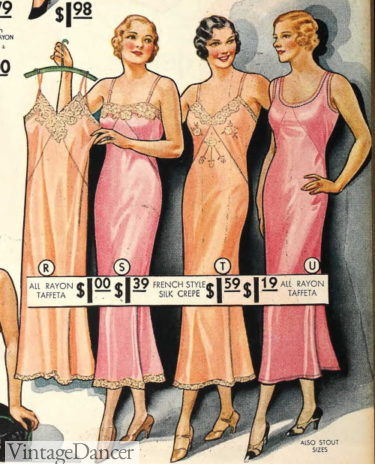
1934 slips- various necklines
Also in the 1930s, the taffeta slip with ruffled hem rustled under fancy afternoon evening gowns. The subtle sounds reminded women of dancing on the silver screen in big sweeping ballgowns with the likes of Fred Astaire. Taffeta was available in colors to match dresses- navy blue, emerald green, burgundy, pink, white, and peach.
- 1933 taffeta slips that “swish”
- 1939 taffeta slips with ruffles hem
Petticoats were less common, but available for women who wore skirts. They either pulled on or wrapped around and buttoned on the side. They could be made of silky crepe, warm knit, or swishy taffeta.
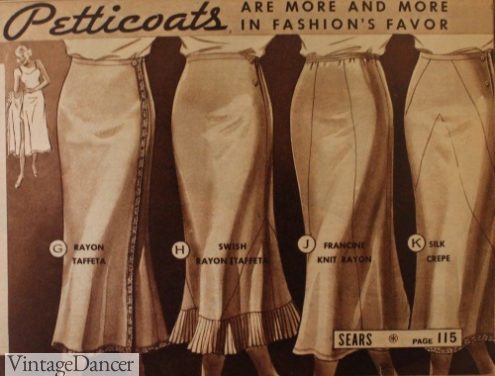
1933 skirt petticoats
1930s Stockings
Women in the 1930s continued to wear back seamed stockings. Hosiery colors were shades of sun-tan, taupe or deep grey with various shades in between. Women with deep skintones choose dark grey or dark tan for their stockings.
Learn more history of 1930s stockings and socks.
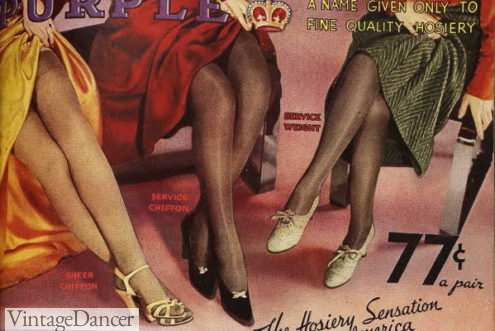
1934 stockings
Shop 1930s inspired lingerie
Reproduction 1930s lingerie is a rare find, and vintage 1930s lingerie has become so collectible that the price point isn’t reasonable anymore. I prefer to wear 1930s inspired lingerie with my clothing and costumes. Most styles lean in the direction of the 1950s-1970s but with an educated eye you can spot some bras, panties and slips that have the look of the 1930s.
At a minimum I reccomend that every woman wear:
- A light bra with granny panties. Cheap bras found in boxes are the best! A bandeaux style is also a good choice for small chested women. Full chests may need a minimizer bra.
- Slip – A full length slip with dresses and skirts. A Cami top for blouses+pants.
- Stockings – I cheat and wear tights with with tummy control. Backseams are ideal but plain is fine too. Choose shades darker then natural skintone.
Optional:
- Shapewear such as an open bottom girdle, all-in one body suit, or tummy control panties do wonders to the figure IF they smooth flesh in the right direction. This will take trial and error to find best brand for you. (1930s silhouettes look best with flesh evenly distributed around the body- not a sharp hourglass.)
- Sew your own vintage lingerie for the most authentic fit and prettiest colors.
Here are some 1930s style lingerie options online:
Debbie Sessions has been teaching fashion history and helping people dress for vintage themed events since 2009. She has turned a hobby into VintageDancer.com with hundreds of well researched articles and hand picked links to vintage inspired clothing online. She aims to make dressing accurately (or not) an affordable option for all. Oh, and she dances too.
